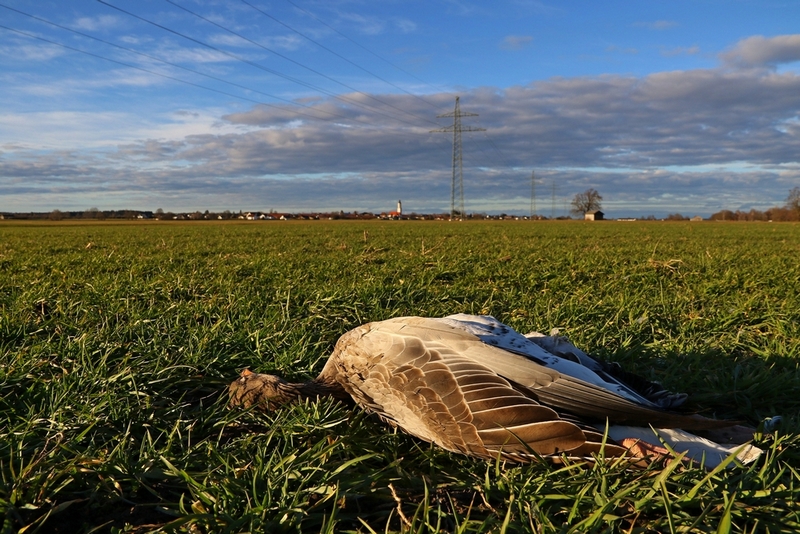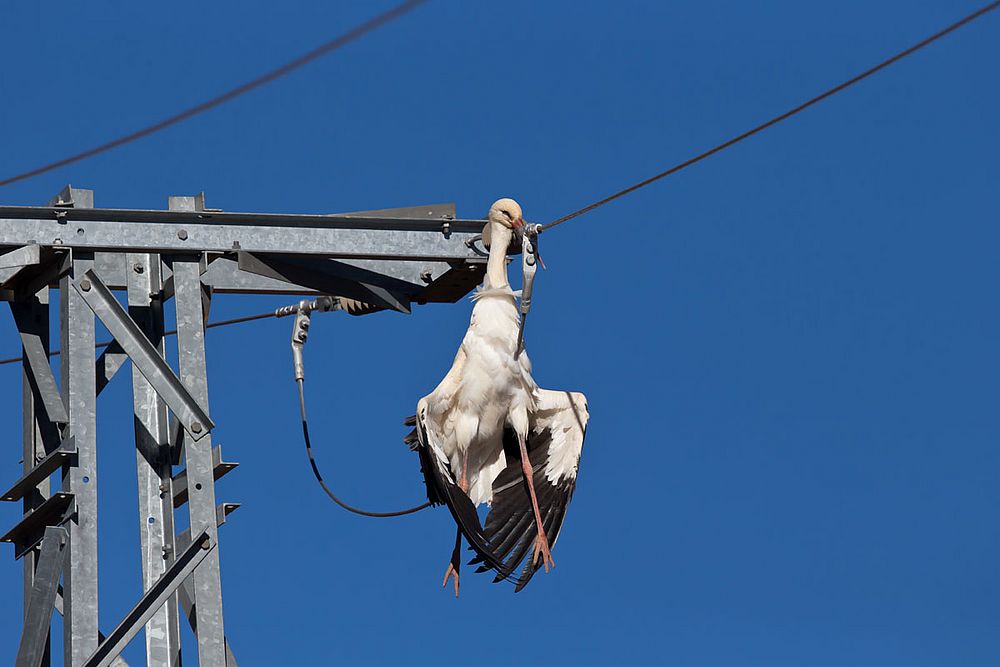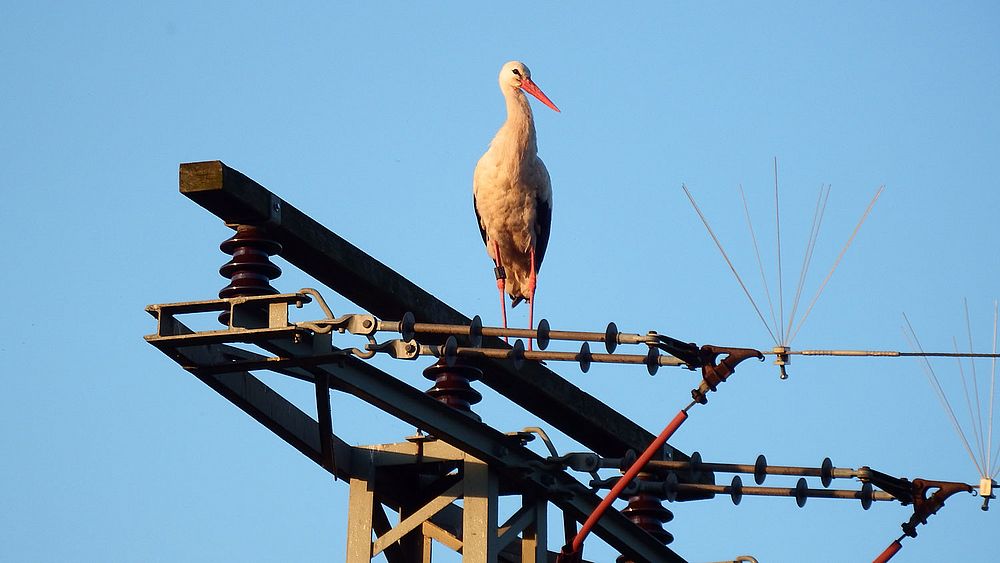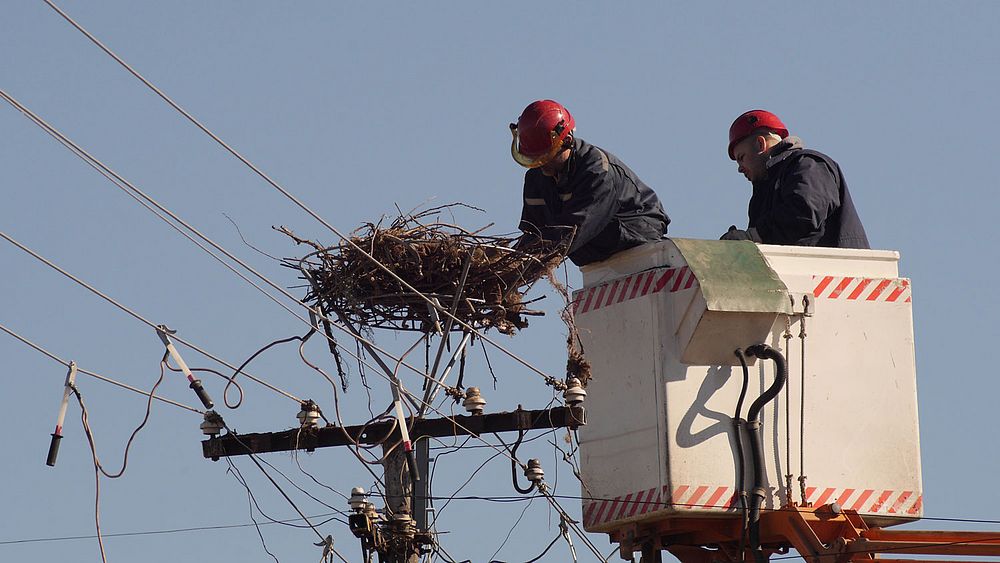Energy
Stop Electrocution!
Throughout the world hundreds of millions of birds get killed each year by overhead power lines. They collide with cables or get electrocuted. Large body size and long wings mean a greater risk of electrocution, so large birds such as storks, raptors and owls are particularly affected. This is further aggravated by the fact that many of these bird species like to perch or nest on the power line poles. Nevertheless, smaller birds get electrocuted too, even down to the size of songbirds such as starlings or sparrows.
Why and how do electrocution and collision occur?

Electrocution can happen through a short circuit, when a bird´s wings bridge the gap between energized wires of different voltages or by ground-fault when the bird touches energized and grounded parts (such as the pole) simultaneously. The electricity that flows through the bird’s body causes severe burns and paralysis. In both cases the bird´s body often shows no conspicuous external damage. The entry and exit marks of the current can be rather small and concealed by the feathers.
There are two main types of power lines that pose a risk for birds. High voltage transmission lines for long distance transport (≥ 60 – 400 kV) and medium voltage distribution lines (2.4 – 60 kV) for sending electricity from the distribution station to the residence or business. The latter are those lines typically seen along roads. Avian electrocutions occur most often on the medium voltage distribution lines, especially on pylons that are constructed with close spacing between the pole or the cross arm and its wires or other energized parts.
High voltage lines use large pylons with multiple cables at different levels. They account for most of the collision victims, because flying birds hit a cable while trying to avoid another one, or simply because of low visibility, or because birds do not expect that sort of obstacle. Bird species prone to collisions with power lines are fast flying and rather large birds with a limited manoeuvrability such as geese (e.g. Anser sp.), grouse and ptarmigans (Tetrao and Lagopus sp.), bustards (Otididae) or cranes (Grus sp.).
What is the scale of the problem?

Research on electrocution and power line collision is complex and difficult, since incidents are spread over large areas and many bodies are quickly taken by scavengers such as foxes and martens. Furthermore, many birds get hurt and die later from their injuries, possibly at long distances from the power line. A scientific review estimates the annual death toll for the United States to be between 8 and 57 million birds killed by power line collision and between 0.9 and 11.6 million birds killed by electrocution.1 The scientists emphasize though, that there is a lack of research, and existing estimates of mortality from power lines may be too low, because collision studies typically focus only on transmission lines (large, high-voltage lines), and electrocution studies focus only on distribution lines (small, mid-voltage lines). Both types of mortality occur on both types of power line, however. The numbers cannot be transferred one to one to Europe and will naturally differ a lot for specific bird groups or habitats. Nevertheless, they illustrate the dimension of the problem.
Power lines add to a growing list of sources of anthropogenic bird mortality – including collisions with cars, buildings or communication towers, predation by domestic cats, habitat change and hunting. In some cases power lines even constitute a significant source of unnatural mortality for already severely threatened species.2 For instance, Spanish ornithologists in a report on a population of the critically endangered Bonelli´s Eagle (Aquila fasciata) in Catalonia have stated that “even low levels of electrocution can drive a local population to extinction”.3 For the Eurasian Eagle-owl (Bubo bubo) power lines are known to be the main cause of mortality in Italian mountain areas.4
A global issue
Over 100 million kilometers of medium-high voltage power lines are in use around the world.5 This is equivalent to 260 times the distance from the earth to the moon or 2500 times the circumference of the equator. New power plants and a steady rise in electricity consumption per capita necessitate the installation of new lines, so the network is estimated to be growing at a rate of about 5 % annually. Therefore, on a global scale, the problems that power lines cause for birds will only increase. Solutions have to be initiated and implemented on a local, regional or national scale – both through cooperation between power suppliers and conservationists, as well as through governments setting a legal framework requiring a bird-friendly construction of power lines.
Why and how to safeguard birds from electrocution and collision

Besides the obvious moral and ethical reasons to safeguard birds and other wildlife from electrocution and collision with power lines, there are also good economic reasons to do so. Electrocution of birds causes power failures and subsequently a loss of revenue, the need for repairs and possibly also the cost of legal compliance for the electricity supplier. Another economic reason to provide for bird-friendly powerlines is the avoidance of wildfires. A study by Francisco Guil and colleagues estimates the costs of “fauna-mediated wildfires” in Spain for the period from 2000 until 2012 to be between €7.6 to 12.4 million.6 With climate change causing drier conditions in many places in Europe, this problem could become even more significant in the future.
The best mitigation measure would obviously be to bury new lines below ground, but since it is more expensive, this option is unfortunately rarely chosen. Nevertheless, the know-how to build or retro-fit electrocution-proof power lines has been available and documented for many years (see for example AEWA Conservation Guidelines No. 147). Effective mitigation measures are, for instance, the insulation of pylons, wires, cross-arms or jumper wires in order to render those components neutral. Attaching the power lines to hanging insulators instead of upright insulators also reduces the problem effectively. Besides the availability of this knowledge, it is still a challenge to raise awareness, to transfer the information to the relevant engineers of the power supplying companies and to identify the high-risk zones where action is most urgent. Only a few countries have implemented legislation that makes electricity suppliers liable for power lines being safe for birds.
Loss, S. R., Will, T., & Marra, P. P. (2014). Refining Estimates of Bird Collision and Electrocution Mortality at Power Lines in the United States. PLoS ONE, 9(7)
Jenkins, A. et al. (2010). Avian collisions with power lines: A global review of causes and mitigation with a South African perspective. Bird Conservation International. 20. 263 - 278.
Hernández-Matías, A. et al. (2015) Electrocution threatens the viability of populations of the endangered Bonelli's eagle (Aquila fasciata) in Southern Europe, Biological Conservation 191. 110–116.
Rubolini, D., Gustin, M., Bogliani, G. and Garavaglia, R. (2005) Birds and powerlines in Italy: an assessment. Bird Conservation International 15: 131–145 and http://datazone.birdlife.org/sowb/casestudy/powerlines-pose-a-threat-to-italian-birds
Own estimate based on data from Jenkins, Smallie, & Diamond, 2010; ABS Energy Research, 2008
Guil, F., et al. (2018). Wildfires as collateral effects of wildlife electrocution: An economic approach to the situation in Spain in recent years. Science of The Total Environment, 625, 460–469.
Frequent victims: White storks and raptors
Electrocution is a particularly big threat to raptors and storks. Firstly, because they are rather big birds with a large wing span and secondly, because of a lack of perching or nesting trees in the open grass- or wetlands where they live. Raptors often get electrocuted when using unsafe pylons or power lines for resting and perching, whilst white storks take a great risk when building their nests on electricity poles. In such cases, parts of the nesting material can act as an electrical conductor and may kill young or adult birds in the nest. Therefore, in areas with many raptors and storks such as the Sakar Hills in Bulgaria or the Extremadura in Spain, there should be an urgent interest in bird-friendly power lines, both for bird conservation and for economic reasons. EuroNatur Foundation and its partners have been campaigning for safe power lines in Europe for several decades. EuroNatur-partner Green Balkans have developed a best practice brochure8 for safeguarding dangerous power lines in Bulgaria in the context of their projects for the conservation of the white stork (Ciconia ciconia) and lesser kestrel (Falco naumanni). Successful mitigation measures include the construction of nest platforms for storks and bird-friendly insulators and reflectors or diverters on the wires. During the summer of 2016 more than 200 power line poles in the Sakar area were rendered safe by applying insulating bird protection caps in close cooperation with the regional power grid operator EVN9.

To avoid collisions is much more of a technical challenge. It may be beneficial to reduce the number of vertical wire levels and, consequently, the collision risk zone, by changing the relative position of the conductors from a multi-level to a single level arrangement. There is also general agreement that wires should be kept as low as possible, span lengths should be kept as short as possible (e.g. by adding a pole mid-span) and cabling used should be as thick as possible.10 Additionally the installation of bird diverters, reflectors and the like can reduce the number of collisions substantially, as Murphy and colleagues demonstrated in the case of the sandhill crane (Grus canadensis) in Nebraska, USA.11 The positive effect of the marking of powerlines has also been shown in the case of the great bustard (Otis tarda) in Austria.12
What else is EuroNatur doing?
EuroNatur is taking part in the international Safe Flyways Energy Project, funded by MAVA Foundation13 and other donors, which is focusing on tackling the threats of electrocution and collision in the Mediterranean region. EuroNatur is contributing especially in the Western Balkans in Slovenia, Croatia, Serbia and Albania to measures to avoid the negative impact on migratory birds on the Adriatic Flyway from the growth in electricity infrastructure. Therefore, EuroNatur is cooperating with local conservation NGOs, power supply companies and governments to reduce bird hazards on existing power lines and to avoid them in the construction of new lines. Best-practice guidelines are updated and adapted to the conditions prevailing in the individual countries. Together with the European Stork Village Network and their local partners, we are increasing public awareness of the problem and implementing pilot projects to show how to safeguard birds from electrocution and collision.
What can you do?
If you want to support our efforts to render our energy infrastructure safe for white storks and other birds across Europe, you can make a donation here.
If you have found a bird killed through electrocution or collision, you may document and share your observation here and send a notification to storkvillages(at)euronatur.org, ideally with pictures and a precise description of location, date and time and the species affected.
Bernardino, J. et al. (2018). Bird collisions with power lines: State of the art and priority areas for research. Biological Conservation, 222, 1–13.
Murphy, R.K. et al. (2009) Effectiveness of avian collision averters in preventing migratory bird mortality from powerline strikes in the Central Platte River, Nebraska.
Raab, R. et al. (2012). Underground cabling and marking of power lines: Conservation measures rapidly reduced mortality of West-Pannonian Great Bustards Otis tarda. Bird Conservation International. 22. 1 - 8.
 Report sighting
Report sighting
Have you seen a white stork or another interesting species of animal, plant or fungus? Make your observation count for nature conservation and share it with other nature lovers! It’s free and it’s fun!





